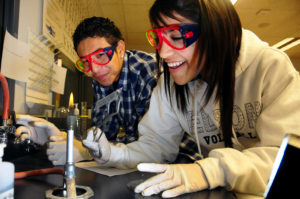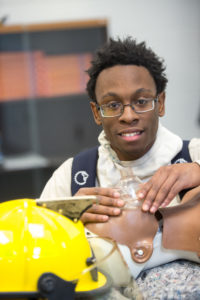ConnectED was founded in 2006 with a belief, and a question. The belief, which still guides our work today, is that every student, especially those furthest from opportunity, deserves a great education. The question was: can a Linked Learning approach work to make that happen? Over the years, partnering with numerous school districts across the country, what started as a hypothesis has since proven to be true: in community after community, a Linked Learning approach has had impressive results in engaging all students, educators, school districts, and the wider communities around them.
The Early Years
With generous support from The James Irvine Foundation, ConnectED initiated and led the California Linked Learning District Initiative, a five-year demonstration in partnership with nine large, high-need districts, collectively serving more than 275,000 high school students of whom more than 75 percent were economically disadvantaged.[1] Linked Learning was seen as an important tool for tackling California’s widening education gap, but only if it could work in districts with large populations of traditionally underserved students.
 During the initial pilot, a multi-year evaluation was conducted by SRI International’s Center for Education Policy (read the SRI Report). It showed that students in certified Linked Learning pathways within the California Linked Learning District Initiative were better prepared to succeed in college, career, and life compared to peers in traditional high school programs. Specifically, compared with their peers, students in certified Linked Learning pathways earned more credits in high school; reported greater confidence in their life and career skills; and said they experienced more rigorous, integrated, and relevant instruction. They were less likely to drop out and were more likely to graduate on time. Furthermore, students who had low achievement scores in earlier grades made significant progress when they participated in Linked Learning. Lastly, the four-year college going rate for African Americans in Linked Learning was twelve percentage points higher than peers not participating in pathways.
During the initial pilot, a multi-year evaluation was conducted by SRI International’s Center for Education Policy (read the SRI Report). It showed that students in certified Linked Learning pathways within the California Linked Learning District Initiative were better prepared to succeed in college, career, and life compared to peers in traditional high school programs. Specifically, compared with their peers, students in certified Linked Learning pathways earned more credits in high school; reported greater confidence in their life and career skills; and said they experienced more rigorous, integrated, and relevant instruction. They were less likely to drop out and were more likely to graduate on time. Furthermore, students who had low achievement scores in earlier grades made significant progress when they participated in Linked Learning. Lastly, the four-year college going rate for African Americans in Linked Learning was twelve percentage points higher than peers not participating in pathways.
Building On Past Success
ConnectED has since supported Linked Learning implementation in more than 20 additional districts in California. In 2014, we began expanding outside of California with major initiatives in Detroit and Houston. Today, we are supporting college and career pathway initiatives in Boston; the Columbus, OH region; Holyoke; Madison; New Orleans; the northwest suburbs of Chicago; Rockford; Providence; and Portland, Oregon.

Altogether over the past decade, we have supported more than forty communities enrolling more than 85,000 students in more than 290 college and career pathways. We’ve trained over 400 Linked Learning coaches, and provided professional development to 2,000 pathway teachers. Today, we are engaged in helping college and career pathways all over the country achieve silver and gold Linked Learning certification—the level of pathway quality that research shows produces significant improvement in student outcomes.
Reaching Every Child
We return to the question: can a Linked Learning approach be used to provide a great education to every child? At ConnectED, we firmly believe that the answer is yes, and we are working with districts across the country to make that happen. We’ve seen the positive impact Linked Learning has had for students – on the individual level, as well as for the classroom, district, and community at-large. It’s is an approach that every child deserves. We’re working hard to build more partnerships across the country to bring high-quality, relevant and rigorous education to all students.
[1] The districts included Antioch, Long Beach, Los Angeles, Montebello, Oakland, Pasadena, Porterville, Sacramento, and West Contra Costa County.
)